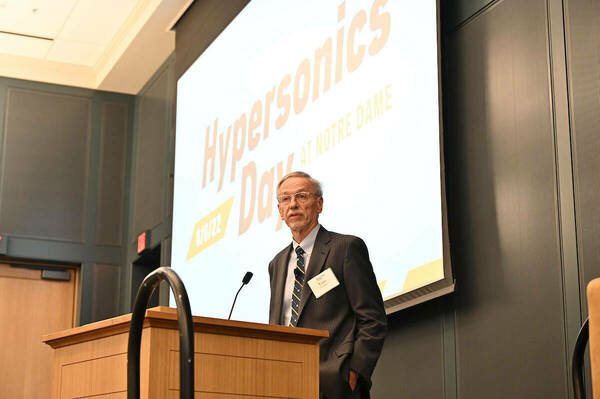
As the United States seeks to strengthen its hypersonics capabilities, government officials recently joined engineers and experts at the University of Notre Dame to discuss how the nation can broaden its efforts to lead the field in both technology and talent.
During a workshop led by Thomas Corke, director of Notre Dame’s Hypersonic Systems Initiative, subject matter experts and thought leaders across the Department of Defense, industry and academia outlined the urgent need to attract and develop the next generation of scientists and engineers as a top national security priority.
The session aimed to define current and future workforce needs, as well as identify best practices and areas for collective action along the full pipeline of hypersonics workforce development — beginning with engaging students at the elementary school level.
The desire to develop hypersonic vehicles, capable of reaching up to Mach 10 speeds, has been a national objective for more than half a century. Competing interests — including the space race and supersonic technologies — have taken center stage, but Corke said the field needs engineers, theoreticians, software engineers, developers and specialists.
“We have to develop a new workforce to rediscover what we knew in the 1950s — and then develop the next level of hypersonic vehicles,” Corke said.
Notre Dame employs a “system of systems approach,” including campus-wide efforts to support government, industry and academic workforce needs. Corke outlined the multidisciplinary aspects of hypersonic technology development and the multi-pronged approach the University takes in its workforce development initiatives.
This approach includes innovative early education programming through a collaboration with the University’s Alliance for Catholic Education (ACE), a service teaching program that provides foundational training and cohorts of teachers to K-12 Catholic schools in all 50 states. ACE incorporates age-appropriate hypersonics teaching elements into its math and science curriculum, helping to reach more children across the nation.
Despite these efforts, workshop attendees acknowledged better coordination was needed for current workforce development initiatives to ensure those efforts are effective. Not enough children are being reached to meet the increasing demand for new workforce entrants.
John Schmisseur, a professor at the University of Tennessee’s Space Institute, cited a steep decline of the workforce from a peak of approximately 10,000 during the National Aerospace Plane era during the 1980s and ’90s to an available workforce of fewer than 3,000 today — many of whom are at retirement age.
The demand for current and future talent far exceeds the existing workforce pool.
Efforts by the Department of Defense’s Joint Hypersonics Transition Office (JHTO) to address these needs were highlighted by Lori Stiglitz, workforce development lead at the JHTO Systems Engineering Field Activity at Naval Surface Warfare Center, Crane. Speaking to the JHTO’s Workforce Development Strategic Framework, Stiglitz emphasized the importance of exposing children to the wide range of technology careers at an early age.
“Research has told us that second graders around the age of 7 or 8 start to limit their career choices,” Stiglitz said. “They do not choose a career at second grade, but if they don’t learn about some of the career options out there and, specifically for us, if they don’t start hearing the terms hypersonics and what that can mean, then they start limiting their options.”
Stiglitz also outlined key occupations within the hypersonic arena, calling attention to the critical need across a wide range of specialties. Software engineers and developers were at the top of her list.
“We have a lot of good going on. But it needs to be coordinated,” she said. “This is not a solo sport. We need to connect.”
Echoing many of the same challenges, Kimberly Jacoby Morris, STEM program coordinator at the Air Force Office of Scientific Research (AFOSR), outlined initiatives underway within the Air Force to attract and retain workforce talent.
“There are a lot of different offices that are now focusing on STEM literacy, STEM workforce development, because it’s an issue of national security at this point,” Jacoby Morris said. “We know that our adversaries are outpacing us in the production of Ph.D. candidates from highly qualified universities. We also know that we have a diversity problem within the STEM workforce.”
The field needs diversity of thought and experience, she added, to generate innovative ideas and creative solutions.
Like the JHTO, AFOSR’s programming begins with outreach and education at the elementary age and continues with retention and training.
“The Department of Defense employs more than 46 percent of the federal STEM workforce,” Jacoby Morris said. “We want the best and the brightest to join us and protect that advancement and support our warfighters.”
Meeting the country’s technological advancements with the necessary talent is nothing short of a huge challenge, said Bryan Woosley, a university liaison from the Naval Surface Warfare Center, Crane. Woosley called the need for workforce development in the field “a national security matter.”
While some students may be exposed to STEM fields through family members or educational programs, Woosley echoed a call to action felt by other attendees to reach those students who might not otherwise be engaged in science, engineering or technology, communicate the importance of serving in the field and motivate future talent at all levels.
“We have a huge task in front of us,” he said.
The workshop was part of Notre Dame’s inaugural Hypersonics Day. The event brought together leading researchers and engineers with representatives from Indiana’s robust hypersonics innovation ecosystem, including researchers from Purdue University and statewide government and industry partners, to discuss the region’s continued leadership in hypersonics innovation.
To view the full Workforce Development Workshop, please click here: https://www.youtube.com/watch?v=xLkDObBMiis.